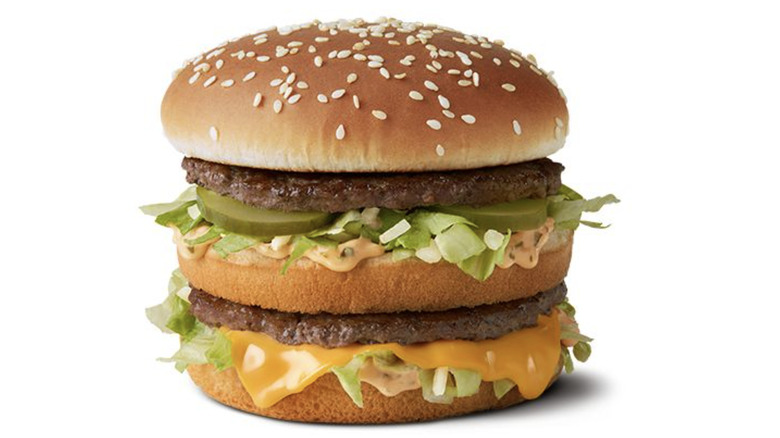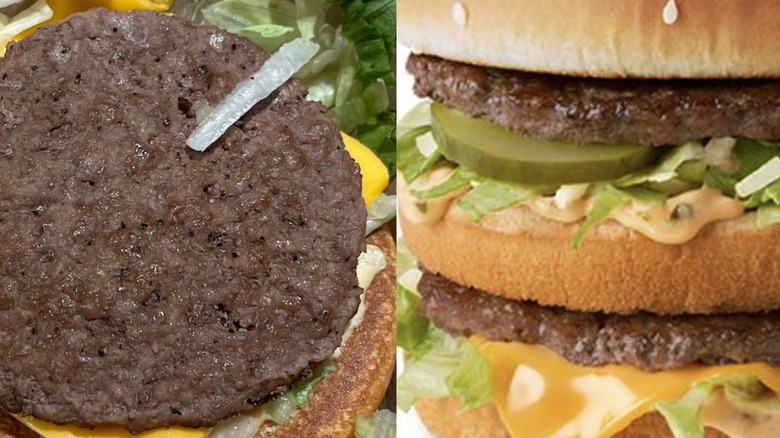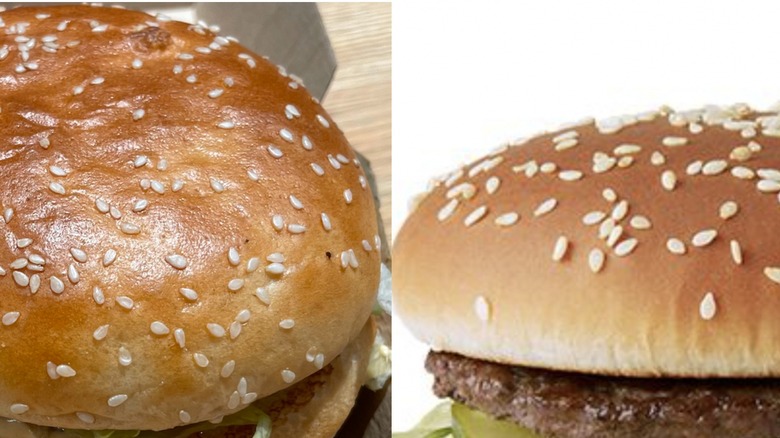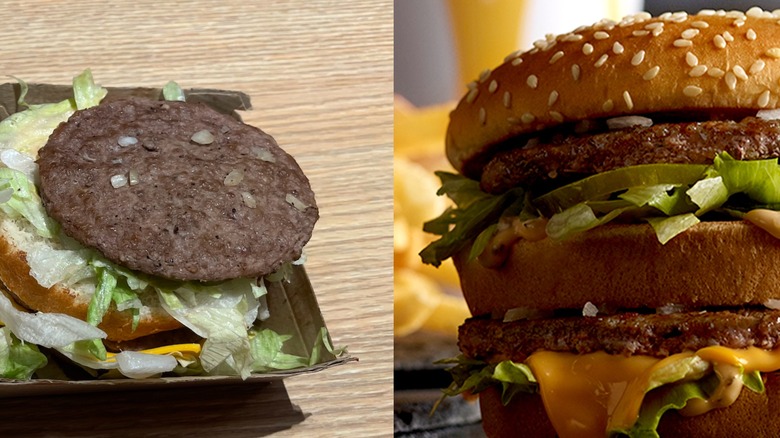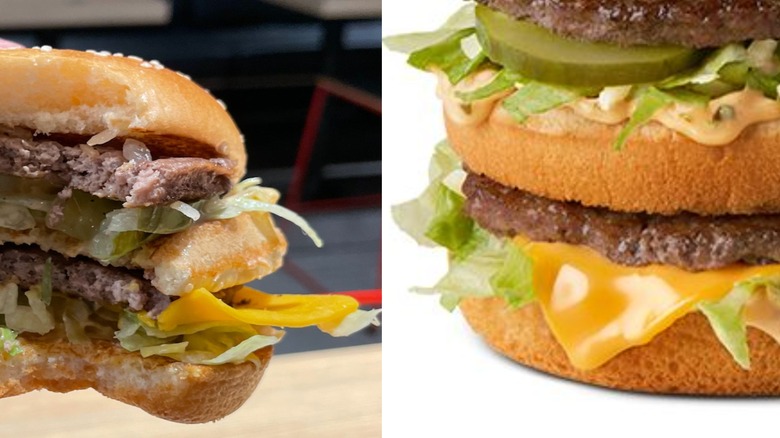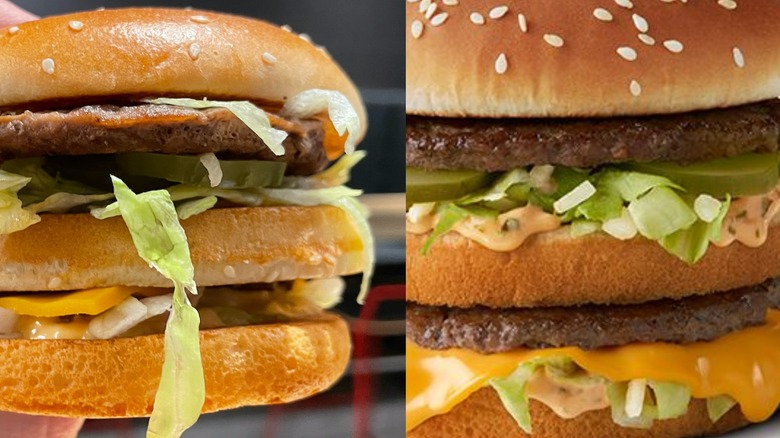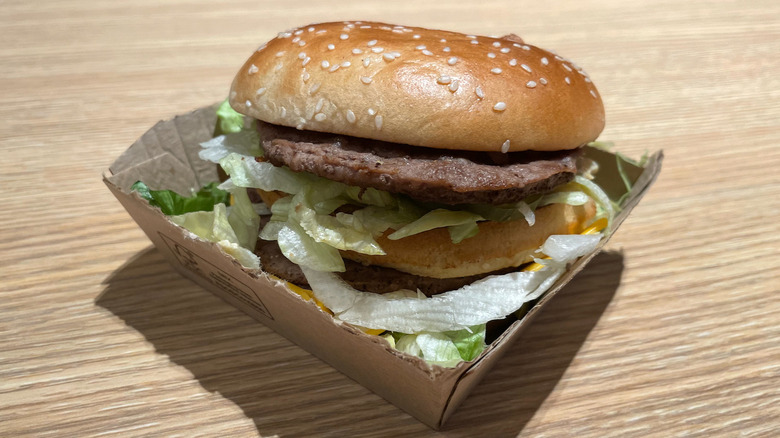McDonald's Big Mac: We Compared The Real Thing To The Ads
With apologies to Burger King's Whopper and In-N-Out's Double-Double, the Big Mac is perhaps the most legendary fast food burger of all time. For people of a certain age, the mere mention of this sandwich's name calls automatically to mind the "two all-beef patties, special sauce, lettuce, cheese, pickles, onions on a sesame seed bun" Big Mac jingle.
The Big Mac has been a staple on McDonald's menus since it was invented by franchisee Jim Delligatti in 1967. That kind of longevity is impressive, but we want to know: Is the Big Mac coasting by on name recognition? This burger never fails to look incredible in the pictures on menu boards or in commercials, but we all know that real-life fast food items frequently fail to live up to those photos. We picked up a Big Mac from our local McDonald's to see how much its appearance deviated from pictures, and we were pleasantly surprised by the way it looked. It didn't taste too bad either.
The patties are just as big as they are in the photo
Unlike many fast food burgers, which look shrunken in person compared with how they are presented in promotional materials, the patties in our Big Mac are the exact size we expected based on the menu picture. Part of that is simply that McDonald's doesn't over-promise in its food photography; the patties are small in the picture, and they are small in real life. A standard McDonald's patty is only a hair over 1.5 ounces of beef, much smaller than any burger you're likely to make at home. With two patties, however, the amount of beef feels satisfying.
Other aspects of the real-life burger patties were a little further from the picture. In official photos, McDonald's burgers always have a beautifully seared crust and a glossy, juicy look. The actual patties we received were more gray than brown and had no real sear. They also didn't have enough juice to make them shiny, though they weren't terribly dry either. Ultimately, the patties are just one component of the complex sandwich creation that is the Big Mac, and they perform their job adequately.
The bun impresses us with its fidelity to the photo
In the past, we've definitely bought Big Macs that looked a little sad and smooshed. The primary culprit for this was always the bun, which sometimes deflated a bit from the weight of all the toppings. That wasn't the case with the sandwich we tasted for this article, however — it was picture-perfect. Each layer was tall and fluffy, not compressed at all. Unlike many other burgers that come in foil or paper wrappers, the Big Mac was served in its own special cardboard box, and the added protection helped keep our burger bun in mint condition.
The primary way the real-life bun differed from the one in the photo was that it looked like it was lacquered in egg wash. There are no eggs in the recipe, so McDonald's must have done something else to give the bun shine, but in any case, it sparkled under the light. We actually preferred the way this looked to the bun in the photo, which was totally matte.
In addition to being quite photogenic, the bun also tasted great. It seemed fresh, and its sweet flavor and fluffy texture set off the savory beef and acidic Big Mac sauce perfectly.
The garnishes are sloppy but decently fresh
It's probably unfair to expect an average fry cook to stack the lettuce on a burger as perfectly as a food stylist would, and indeed, the lettuce on our Big Mac seems to be applied to the sandwich pretty haphazardly. We wouldn't want a McDonald's worker to have to stand over our burger for 15 minutes delicately arranging shredded iceberg with tweezers, so the sloppy lettuce doesn't bother us.
It wasn't the freshest-tasting or perkiest fast food lettuce we've ever had, but it still provided some moisture and crispness. The real stars of the show, in terms of garnishes, were the pickles and finely minced onions. Although they weren't crunchy at all, they injected quite a bit of sourness into the proceedings. The Big Mac was designed for balance — the sour sharpness of the pickle and onion would be excessive on its own, but when paired with the sugary bun and the fatty beef and cheese, everything made sense.
One problem with all the garnishes was that they made the sandwich hard to eat. A few bites in, all the components began slipping around and threatening to fall apart. Once we started eating our Big Mac, we couldn't put it down until it was finished for fear that it would disintegrate if we let go of it.
The cheese is not melted at all
In official photos from McDonald's, the single piece of cheese on the bottom deck of the Big Mac was always beautifully melted, with the corners starting to ooze down the sides of the bun. The cheese on the sandwich we received could not have looked more different from the picture. It was room temperature and completely unmelted — still just as perfectly square as it was when a McDonald's worker removed it from its plastic packaging.
The way the Big Mac is assembled makes it unlikely that you're going to receive one with melty cheese in real life. When you make a cheeseburger at home, you generally add the cheese on top of the patty when it's still on the griddle, or maybe just after it's been removed from the heat. The hot beef melts the cheese quickly. However, on a Big Mac, the cheese is placed next to a cold layer of special sauce and lettuce, then a cooked burger patty is placed on top. The cold garnishes keep the cheese on our burger cool, preventing it from melting.
Despite the lack of gooeyness, the cheese still does its job, adding a creamy dairy flavor that goes well with all the other components. We just don't know why McDonald's doesn't put the cheese on top of one of the patties instead of on the bottom of the sandwich.
The sauce makes the sandwich sing
The Big Mac sauce on our sandwich looks basically like it does in the picture: a faded orange-pink color studded with flecks of pickles. The main difference is that in the picture, the sauce is enticingly dripping out of the sandwich, while the sauce on the real-life Big Mac stays safely ensconced in the bun. We prefer it this way; oozing sauce looks great in a photo, but it's pretty annoying to deal with when you're trying to eat without making a mess.
Big Mac sauce is in the same genre as other special burger sauces like In-N-Out's spread or Shake Shack's Shack sauce. Unlike those other condiments, however, Big Mac sauce is ketchup-free — its pink color comes from paprika. Its use of oil and egg yolks leads us to believe it's mayo-based, and it also contains pickle relish. The recipe includes hydrolyzed protein, an umami-boosting flavor enhancer with similar properties to MSG. Maybe that's the secret ingredient — whatever it is, this sauce really amps up the taste of everything else in the burger. We'd consider ordering a cup on the side to dip our fries into next time.
The verdict: How does the Big Mac measure up to the photo?
No fast food item is ever going to look exactly like the fantasy images found in advertisements, but we are impressed by the appearance of our Big Mac. Other than being put together a little more carelessly than the ones in ads, the real-life Big Mac lives up to our expectations. We are especially surprised by how perfect and tall the bun is — the fluffy triple-decker burger bun really helps sell the appearance of the sandwich and makes it look like the ideal Big Mac of our dreams.
The overall flavor is just as nice as the aesthetics. The Big Mac feels like a magic trick; none of the components of the sandwich (except maybe the sauce and the bun) are particularly appealing by themselves. Could you imagine eating a McDonald's burger patty outside of a sandwich? It would be gross. But somehow, when everything is put together in the right ratios, some kind of dark alchemy happens to produce the iconic, compelling flavor of the Big Mac. There's a reason this menu item has stuck around at McDonald's for decades.
